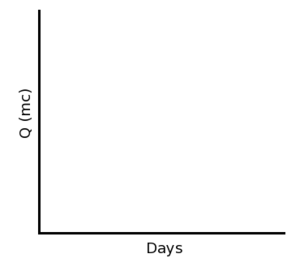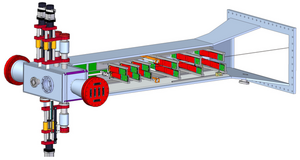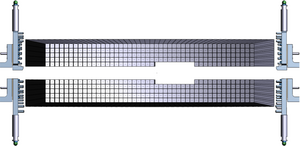Difference between revisions of "The HPS Run Wiki"
| Line 137: | Line 137: | ||
| valign=top | | | valign=top | | ||
| − | + | ||
| Line 143: | Line 143: | ||
<font color='red'> PUT BEAM BLOCKER IN FOR LONG RUNNING AT HIGH CURRENT</font><br> | <font color='red'> PUT BEAM BLOCKER IN FOR LONG RUNNING AT HIGH CURRENT</font><br> | ||
| − | == Run Plan:March | + | == Run Plan:March 25-26, 2015 (day/swing/owl) == |
| − | + | Yesterday: Beam tuning to tagger dump day and swing and owl made large improvements but didn't completely converge. Didn't get to alcove or bpm calibrations. | |
| − | + | CHL trip has had machine off since 4AM today. Hall B in restricted access for torus work. Will lock up at 4PM. Shifts resume at swing. | |
| − | Program: 1) MCC re-tunes upstream beam;(2) When beams are acceptable, MCC restores beams to alcove;(3) When decent beams have been reestablished, calibrate downstream bpms (4) post calibration, require good spot on Chromax, low counts on halo counters, and then set-up chicane. 5) scan target vertically and horizontally, measure halo rates vs target; (5) Take data. Subsystem commissioning studies: more trigger commissioning studies, beam trip studies once orbit locks are on. | + | Today we try again. Program: 1) MCC re-tunes upstream beam;(2) When beams are acceptable, MCC restores beams to alcove;(3) When decent beams have been reestablished, calibrate downstream bpms (4) post calibration, require good spot on Chromax, low counts on halo counters, and then set-up chicane. 5) scan target vertically and horizontally, measure halo rates vs target; (5) Take data. Subsystem commissioning studies: more trigger commissioning studies, beam trip studies once orbit locks are on. |
'''<font size=3> MCC works on beam optics and matching, and tunes beam to tagger </font>''' | '''<font size=3> MCC works on beam optics and matching, and tunes beam to tagger </font>''' | ||
| Line 165: | Line 165: | ||
* Insert Chromax screen on the downstream viewer | * Insert Chromax screen on the downstream viewer | ||
* 4mm SVT Protection collimator in place | * 4mm SVT Protection collimator in place | ||
| − | * Restore 1 nA CW beam and have MCC bring beam to y~-5mm; x~5mm on the Chromax screen. (distance between dots=5mm). Record spot. Record scalers. Repeat and record 2C21 and 2C24 harp scans and corrector settings. | + | * Restore 1 nA CW beam and have MCC bring beam to y~-5mm; x~5mm on the Chromax screen. (distance between dots=5mm). Record spot. Record scalers. Repeat and record 2C21 and 2C24 harp scans and corrector settings. We need these for next time! |
* Record position at 2H02 harp. Repeat at 10 nA. Must have good spots, nominal sizes, no tail to proceed. Position ok? | * Record position at 2H02 harp. Repeat at 10 nA. Must have good spots, nominal sizes, no tail to proceed. Position ok? | ||
* record scalers and beam location on screen. | * record scalers and beam location on screen. | ||
| Line 171: | Line 171: | ||
'''<font size=3> Energize Chicane </font>''' | '''<font size=3> Energize Chicane </font>''' | ||
| − | * follow standard procedures | + | * follow standard procedures in Chicane Writeup |
* beam spot on Chromax should be unmoved. If not, tune Frascati slightly. See caution below. | * beam spot on Chromax should be unmoved. If not, tune Frascati slightly. See caution below. | ||
| Line 178: | Line 178: | ||
* Turn beam off and insert HPS target, 4um W. Restore beam. Check count rates. | * Turn beam off and insert HPS target, 4um W. Restore beam. Check count rates. | ||
* Do horizontal scan of beam on target. Using table provided, first change Frascati settings, then PS settings to move beam left and right on the target with ~1mm step. Small changes only. Return to nominal beam position. | * Do horizontal scan of beam on target. Using table provided, first change Frascati settings, then PS settings to move beam left and right on the target with ~1mm step. Small changes only. Return to nominal beam position. | ||
| − | * Do vertical scan of target at | + | * Do vertical scan of target at nominal beam position. Measure halo counter/ecal rates vs target position. Record data and graph. |
| − | Are we centered? | + | Are we centered? Beamline Expert should enter new target positions if not. |
* Do scan of SVT collimator, measuring counter rates vs SVT collimator position with nominal beam position. | * Do scan of SVT collimator, measuring counter rates vs SVT collimator position with nominal beam position. | ||
* If Omar and beamline expert are available during day or swing, do SVT Wire Scan. This still needs an expert. Orbit locks must be temporarily removed to move beam horizontally with upstream correctors, if needed. Restore orbit locks when done. | * If Omar and beamline expert are available during day or swing, do SVT Wire Scan. This still needs an expert. Orbit locks must be temporarily removed to move beam horizontally with upstream correctors, if needed. Restore orbit locks when done. | ||
| Line 187: | Line 187: | ||
* Make sure DAQ is OK for data taking | * Make sure DAQ is OK for data taking | ||
* More Trigger commissioning data runs. See [[Media:HPS_TriggerCommissioning_March2015.pdf|Valery's note]] on the run Wiki under commissioning trigger. | * More Trigger commissioning data runs. See [[Media:HPS_TriggerCommissioning_March2015.pdf|Valery's note]] on the run Wiki under commissioning trigger. | ||
| − | * | + | * If orbit locks are on, call Rafayel for beam trip study. Take 4 hours of beam trip data with wire up; take 4 hours of beam trip data with wire down. |
* Absent other requests, take data at 50 nA. Be sure to block Faraday cup if higher current. | * Absent other requests, take data at 50 nA. Be sure to block Faraday cup if higher current. | ||
Revision as of 08:24, 25 March 2015
Important Phone NumbersShift ScheduleShift-Taker's Checklist (old)Hot CheckoutBeam Time Accounting |
Procedures |
Manuals |
JLab Logbooks
|
RC: John Jaros
PDL: Stepan StepanyanEvery Shift:
SVT InstructionsBefore sending beam to Faraday cup, verify (and page expert if otherwise):
The first time sending beam to the Faraday cup after the hall is closed, page the SVT expert.
Acceptable Beam Conditions:Before accepting beam, make sure all the conditions are met - beam profile and halo rates are what you expect (or very close to it). If unsure call to RC, PDL, or beamline expert!
Always read previous log entries, compare settings of BPMs and correctors with previous settings using scaler_hps GUI. Every Run:
|
Run Plan:March 25-26, 2015 (day/swing/owl)Yesterday: Beam tuning to tagger dump day and swing and owl made large improvements but didn't completely converge. Didn't get to alcove or bpm calibrations. CHL trip has had machine off since 4AM today. Hall B in restricted access for torus work. Will lock up at 4PM. Shifts resume at swing. Today we try again. Program: 1) MCC re-tunes upstream beam;(2) When beams are acceptable, MCC restores beams to alcove;(3) When decent beams have been reestablished, calibrate downstream bpms (4) post calibration, require good spot on Chromax, low counts on halo counters, and then set-up chicane. 5) scan target vertically and horizontally, measure halo rates vs target; (5) Take data. Subsystem commissioning studies: more trigger commissioning studies, beam trip studies once orbit locks are on. MCC works on beam optics and matching, and tunes beam to tagger
Standards are on this page: ACCEPTABLE BEAM CONDITIONS.
Restore Beam to the Hall-B Dump
Energize Chicane
Be very careful when changing magnet currents when beams are on. Must enter new current ACCURATELY. Small steps (few amps) only.
Are we centered? Beamline Expert should enter new target positions if not.
Subsystem Commissioning Studies. Begin Data Taking.
| ||||||||||||||||||||||||||||||||||||||||||||||
|
|
| ||||||||||||||||||||||
|
|
|
| ||||||||||||||||||||||||||||||||||||||||||||||
|
Webcams:
|
Slow Controls: |
Accelerator:
|
Online & Offline: |


